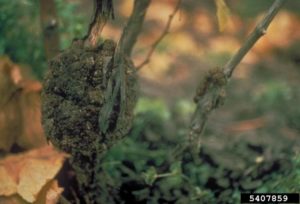 COMMON NAME: Crown Gall of Grapevine
COMMON NAME: Crown Gall of Grapevine
SCIENTIFIC NAME: Agrobacterium vitis (A. vitis)
DISEASE DESCRIPTION:
Galls are masses of tumor-lilke cells on a plant’s stem caused by several bacterial species within the genus Agrobacterium. A species of Agrobacterium that affects only grapevines is Agrobacterium vitis. The galls caused by A. vitis on an infected grapevine lead to stunting and a reduction in grape quality of infected plants. The bacterium can cause economic loss by making grape production less profitable and, if the infection is severe enough, can kill a grapevine by girdling the stem with galls.
SYMPTOMS:

Photo credit: John Hartman, University of Kentucky, Bugwood.org
The most common symptom of this disease is the appearance of galls on the stem, especially near the crown (or base) of the plant. Galls may also appear on wounded tissues on trunks and cordons when the bacterium spreads systemically through the vine vascular system. Galls are abnormal lumps on the surface of stems that grow in volume as the disease progresses. As the galls increase in size, the grapevine becomes more stunted and loses vigor. The grapes are especially affected; heavily symptomatic grapevines produce less grapes overall, and grape development and quality are also affected.
BIOLOGY:
Agrobacterium is a genus of hardy soil-dwelling bacteria. They infect a plant by entering through wounds in the roots. Wounds can be caused by workers in the field, the environment (freezes), and other pathogens (nematodes). Infected nursery materials are often a source of spread into a vineyard.
After entering a plant host through a wound site, A. vitis releases hormones that “trick” the plant into growing uncontrollably at the site of infection. The plant grows large cells that divide frequently, and soon a gall takes shape. This gall acts as a nutrient sink – the plant sends its metabolic products (sugars) to the gall where A. vitis then feasts. The result is a stunted plant that does not produce good fruit because the sugars manufactured in the leaves are partially diverted into the gall rather than the grapes. By causing the plant to grow abnormally, A. vitis ensures that a supply of nutrients is always available for it to consume and proliferate. As the gall grows, pieces of the outer layer drop off into the soil, so that the bacterium is then able establish growth and survive in the vineyard floor.
MANAGEMENT METHODS:
There are no methods of eradicating A. vitis, but measures can be taken to mitigate its effects or reduce its incidence. Farmers can help prevent the incidence of A. vitis by planting varieties of grapevines that are resistant to the bacterium. Purchasing grapevines from certified disease-free stock and planting in an area free of the bacterium can also drastically reduce disease incidence. Sanitizing all tools used in the field prevents the spread of pathogens as well.
If a grapevine is found that exhibits gall-like symptoms, tests should be taken immediately to diagnose any pathogens that may be present. After the presence of A. vitis is confirmed, methods for preventing wounds should be implemented. Some pathogens, such as nematodes, are capable of spreading infection by feeding on roots and causing wounds through which A. vitis and other pathogens may enter. The bacterium can also survive over 2 years in dead roots and other infected material, therefore infected plants and their debris should be removed from fields and destroyed. If switching to a resistant variety of grapevine is impossible, grafting scions of the susceptible grapevine onto the rootstock of resistant varieties can help prevent gall formation. Biological control can be achieved by adding the commercially-available non-pathogenic strain Agrobacterium radiobacter to infested soils that causes competition between the two bacteria, leading to less A. vitis overall.
RESOURCE LINKS*:
https://agrilife.org/harrishort/2015/07/21/crown-gall/
https://www.sciencedirect.com/topics/agricultural-and-biological-sciences/agrobacterium-vitis
http://entoweb.okstate.edu/ddd/diseases/cg-grape.htm
This factsheet is authored by
Cesar Urrutia
pursuing a Ph.D. in Plant Pathology (PLPM)
Factsheet information for the plant health issues represented by the images on the 2020 TPDDL calendar were written by graduate students enrolled in the Department of Plant Pathology & Microbiology DR. DAVID APPEL’s Graduate level Introductory Plant Pathology course (PLPA601) in the 2019 Fall semester. This exercise provides an opportunity for a high impact learning activity where the students are tasked with producing an informational output directed to the general public. This activity provides an opportunity for the students to write and produce a (hopefully) useful product to communicate information on plant health issues to the public.